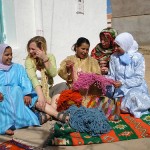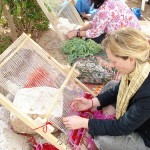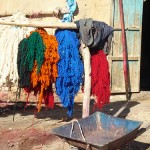 The dullness of British winter falls upon us, yet I am still fighting the urge to keep greys and blacks at the front of my wardrobe. I sometimes think I wear black as if in mourning for summer itself, and so a holiday which actually celebrates colour offered the perfect medicine to beat my SAD symptoms. It was a trip to work with Berber rug weavers on the Plains of Marrakech in Morocco. Gauguin once told his students “O, Painters who are looking for a colour technique look at rugs”. Personally, I was just hoping to weave my way out of winter misery.
The dullness of British winter falls upon us, yet I am still fighting the urge to keep greys and blacks at the front of my wardrobe. I sometimes think I wear black as if in mourning for summer itself, and so a holiday which actually celebrates colour offered the perfect medicine to beat my SAD symptoms. It was a trip to work with Berber rug weavers on the Plains of Marrakech in Morocco. Gauguin once told his students “O, Painters who are looking for a colour technique look at rugs”. Personally, I was just hoping to weave my way out of winter misery.
This is a women-only holiday, as it is traditionally the women who weave in the Moroccan home. Not risqué enough to tackle Marrakech alone, it seemed ideal to travel with some fellow female adventurers, a small group never exceeding eight. Ingrid, the English textile designer who runs this trip, greeted us at Gatwick, with a smile as big as her enthusiasm for the journey we were all about to embark upon.
I had never done the ‘group’ thing before, and was relieved to find I had plenty in common with the others, particularly the two Americans who had travelled from Vermont to share this experience. One of them was Margot, an eighty year old wood-cut print artist, with long flowing white locks, and enough colourful stories from her worldwide travels to allay any concerns about group travel.
The first day was spent acclimatising inside the city walls of Marrakech’s Medina. It was pure theatre, where the actors seemed to enjoy the show as much as the spectators. I confess to having had preconceptions of seediness, and was relieved to discover a different world altogether than the one I had created in my head. Marrakech is a fun, warm place where everyone, orange vendors, artists and snake charmers alike, welcomed us with a smile, shared tea and stories, and giggled at, rather than mocked my ineffectual bartering techniques. Mohamed, our local guide was on hand at all times to help us shop, learn Arabic phrases, and get to grips with the local currency, Dirhams.
We started our weaving journey on day two, taking the 160 kilometres of dusty road across the Plains, known locally as Haouz, to the coastal town of Essaouira, our home for the rest of our stay. The landscape turned quickly from luscious olive and orange groves, to arid stony plains dotted with sheep. We stopped halfway at Sidi Mokhtar which, at first, resembled the rubble of a bombed-out village. This is Morocco’s weaving region, and home to thousands of people who survive on extremely basic means. It was also where we were going to learn to weave. The silence in the car signified a certain shock, as we took in the surrounding poverty. If Marrakech hadn’t taken us out of our comfort zone, here was the definitive wake-up call that this was going to be no ordinary holiday.
These villagers are settled nomads, from the Saharan tribe, Ait Bousbaa. There are signs everywhere of their rich weaving culture. Outside one building, a carpenter was building frames for hand looms, piles of wool sat in front of another, bright reds and oranges flashed through the doors of a small weaving factory. Finally, we went through some gates into an enclosed garden full of Bougainvillea, olive trees and herbs. We were welcomed by four smiling Moroccan women, our teachers, who offered open arms and copious kisses. This was the whitewashed, traditional Moroccan, and spacious home of Zinaib, her daughter, Khadija, and fellow-weavers, Rabha and Hassna. The uproarious welcome echoed around the village, shattering any of our earlier discomfort. After copious amounts of mint tea, home-made bread, nuts and more hugs, we travelled on to our hotel on the coast, glad to have touched base with these wonderful women, before starting work proper.
her daughter, Khadija, and fellow-weavers, Rabha and Hassna. The uproarious welcome echoed around the village, shattering any of our earlier discomfort. After copious amounts of mint tea, home-made bread, nuts and more hugs, we travelled on to our hotel on the coast, glad to have touched base with these wonderful women, before starting work proper.
The wind coming in off the Atlantic in Essaouira was a relief after the dusty drive. To my absolute joy, our new hotel was none other than the Hotel des Couleurs. It lived up to its name, each room themed from an eclectic palette of fuchsia, lime green, scarlet and lemon.
The next few days were spent back at Zinaib’s, learning every stage of the weaving process. First, the girls showed us how to spin wool on a hand-made wheel. I found it impossibly hard, and watched on, in awe, as they demonstrated what they described as banale, but which we found almost magical in its purety. Then we ‘warped up’ our weaving frames with cotton, and chose colours we wanted to work with from a sample selection, in preparation for the visit to the dyers the following day.
This nearby dyers was like the centre of a volcano, where sweating men poured red and purple dyes into bubbling stone vats. The blood-like piles of wool were then piled onto wheelbarrows and taken out to be spread on the rubble, to dry in the scorching sun. There is nothing natural or beautiful about this process. As I watched the stream of red chemicals flow out onto the streets, the men wiping their streaming eyes from the effects of this arduous chemical onslaught, my rose-tinted glasses were quickly tainted.
This was not a fast paced holiday, and I revelled in the time given to looking and learning before any loops or looms came our way. Evenings were spent back in Essaouira, which comes alive when the fishing boats come in. An array of blue wooden boats, all tightly moored together, cover the sea with a blanket of undulating indigo, with fishermen jumping from one to another to compare catches. It is a hub of excitement and commerce, and a joy to behold a fishing port doing real business. No surprise then, that I ordered fresh fish tagine on several of our nightly restaurant outings.
 We spent the next three days in Zaineb’s garden, just weaving. And wittering. Then weaving again. Slowly pushing and pulling our brightly coloured wools through the cotton warp, and gradually trusting ourselves to let go of our gentle teachers’ hands.
We spent the next three days in Zaineb’s garden, just weaving. And wittering. Then weaving again. Slowly pushing and pulling our brightly coloured wools through the cotton warp, and gradually trusting ourselves to let go of our gentle teachers’ hands.
The palette of colours we played with as we wove, was reflected in the colourful array of conversations which took place in the process. Travellers’ tales, political debate, cultural exploration and family stories. No hints of the ‘knitting circle’ trivia I had feared, when teased by friends back home when they heard what I was doing.
The Moroccan girls told us how much they enjoyed this cultural exchange, as well as the extra income. They are paid well above their normal weaving wages for training us, and the amount of laughter in the house confirmed their obvious willingness to participate in this tourist venture. Ingrid is a firm believer in sustaining the local economy through tourism. As well as providing income to the weavers, she uses locally-owned accommodation, family-owned restaurants, and of course, the services of Mohamed, our invaluable and charming local guide. One visitor was a little unhappy with the budget-style accommodation, and lack of ensuite facilities, considering the price of the package. However, when I priced the rooms, added flights, meals, and salaries, I concluded the cost to be reasonable. If you don’t mind eating out of the same giant family couscous bowl at lunchtime, then you won’t mind sharing a bathroom.
You can’t put a price on spending quality time with women from a completely different culture. We swapped skills, were dressed up in Saharan jellabahs, had our feet painted with henna, and our eyes with kohl. And we all, Moroccan, European, and American, laughed a lot. On my last day, I cut my work away from its warp strings and held the mere two feet square of reds, oranges and pinks close up to my face, as if to inhale all the goodness from this priceless experience. But you can’t bottle something like this. You just have to experience it.
Catherine travelled with Ingrid Wagner Real Life Journeys. See www.ingridwagner.com for details. Eight day weaving holiday £925 including flights. Other Real World Journeys include cookery, painting and culture tasters.
Catherine flew with Easyjet from Gatwick to Marrakech. Flights from £29.99 one way.
(This article was first published in The Observer 25 January 2009). For more photos of this trip, click here.
